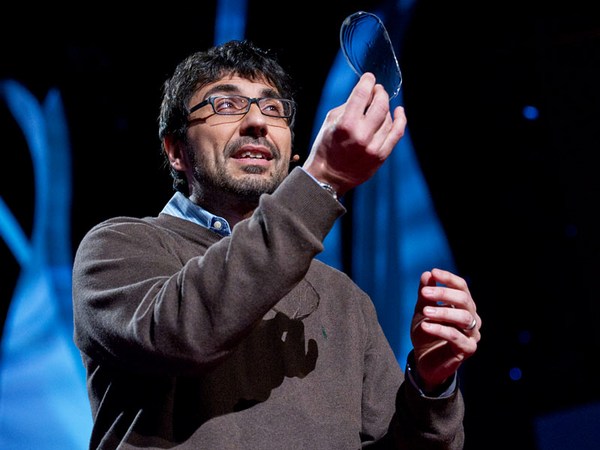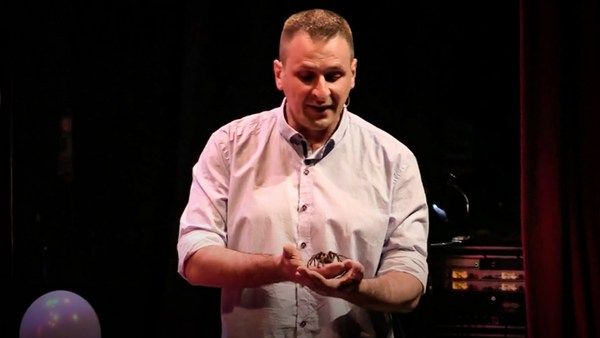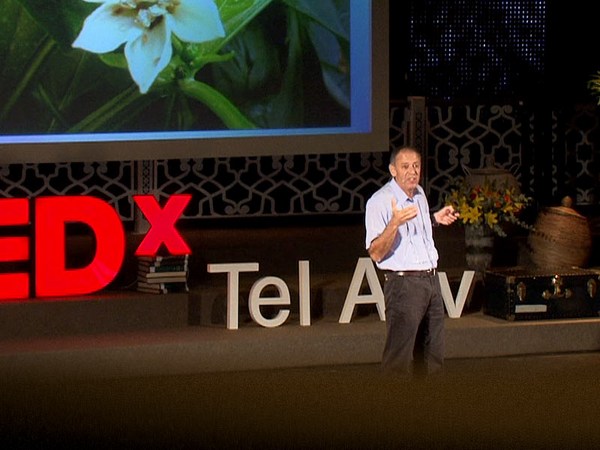I'm here to spread the word about the magnificence of spiders and how much we can learn from them. Spiders are truly global citizens. You can find spiders in nearly every terrestrial habitat. This red dot marks the Great Basin of North America, and I'm involved with an alpine biodiversity project there with some collaborators. Here's one of our field sites, and just to give you a sense of perspective, this little blue smudge here, that's one of my collaborators. This is a rugged and barren landscape, yet there are quite a few spiders here. Turning rocks over revealed this crab spider grappling with a beetle.
Spiders are not just everywhere, but they're extremely diverse. There are over 40,000 described species of spiders. To put that number into perspective, here's a graph comparing the 40,000 species of spiders to the 400 species of primates. There are two orders of magnitude more spiders than primates. Spiders are also extremely old. On the bottom here, this is the geologic timescale, and the numbers on it indicate millions of years from the present, so the zero here, that would be today. So what this figure shows is that spiders date back to almost 380 million years. To put that into perspective, this red vertical bar here marks the divergence time of humans from chimpanzees, a mere seven million years ago.
All spiders make silk at some point in their life. Most spiders use copious amounts of silk, and silk is essential to their survival and reproduction. Even fossil spiders can make silk, as we can see from this impression of a spinneret on this fossil spider. So this means that both spiders and spider silk have been around for 380 million years. It doesn't take long from working with spiders to start noticing how essential silk is to just about every aspect of their life. Spiders use silk for many purposes, including the trailing safety dragline, wrapping eggs for reproduction, protective retreats and catching prey.
There are many kinds of spider silk. For example, this garden spider can make seven different kinds of silks. When you look at this orb web, you're actually seeing many types of silk fibers. The frame and radii of this web is made up of one type of silk, while the capture spiral is a composite of two different silks: the filament and the sticky droplet. How does an individual spider make so many kinds of silk? To answer that, you have to look a lot closer at the spinneret region of a spider. So silk comes out of the spinnerets, and for those of us spider silk biologists, this is what we call the "business end" of the spider. (Laughter) We spend long days ... Hey! Don't laugh. That's my life. (Laughter) We spend long days and nights staring at this part of the spider. And this is what we see. You can see multiple fibers coming out of the spinnerets, because each spinneret has many spigots on it. Each of these silk fibers exits from the spigot, and if you were to trace the fiber back into the spider, what you would find is that each spigot connects to its own individual silk gland. A silk gland kind of looks like a sac with a lot of silk proteins stuck inside. So if you ever have the opportunity to dissect an orb-web-weaving spider, and I hope you do, what you would find is a bounty of beautiful, translucent silk glands.
Inside each spider, there are hundreds of silk glands, sometimes thousands. These can be grouped into seven categories. They differ by size, shape, and sometimes even color. In an orb-web-weaving spider, you can find seven types of silk glands, and what I have depicted here in this picture, let's start at the one o'clock position, there's tubuliform silk glands, which are used to make the outer silk of an egg sac. There's the aggregate and flagelliform silk glands which combine to make the sticky capture spiral of an orb web. Pyriform silk glands make the attachment cement -- that's the silk that's used to adhere silk lines to a substrate. There's also aciniform silk, which is used to wrap prey. Minor ampullate silk is used in web construction. And the most studied silk line of them all: major ampullate silk. This is the silk that's used to make the frame and radii of an orb web, and also the safety trailing dragline.
But what, exactly, is spider silk? Spider silk is almost entirely protein. Nearly all of these proteins can be explained by a single gene family, so this means that the diversity of silk types we see today is encoded by one gene family, so presumably the original spider ancestor made one kind of silk, and over the last 380 million years, that one silk gene has duplicated and then diverged, specialized, over and over and over again, to get the large variety of flavors of spider silks that we have today. There are several features that all these silks have in common. They all have a common design, such as they're all very long -- they're sort of outlandishly long compared to other proteins. They're very repetitive, and they're very rich in the amino acids glycine and alanine. To give you an idea of what a spider silk protein looks like, this is a dragline silk protein, it's just a portion of it, from the black widow spider. This is the kind of sequence that I love looking at day and night. (Laughter)
So what you're seeing here is the one letter abbreviation for amino acids, and I've colored in the glycines with green, and the alanines in red, and so you can see it's just a lot of G's and A's. You can also see that there's a lot of short sequence motifs that repeat over and over and over again, so for example there's a lot of what we call polyalanines, or iterated A's, AAAAA. There's GGQ. There's GGY. You can think of these short motifs that repeat over and over again as words, and these words occur in sentences. So for example this would be one sentence, and you would get this sort of green region and the red polyalanine, that repeats over and over and over again, and you can have that hundreds and hundreds and hundreds of times within an individual silk molecule.
Silks made by the same spider can have dramatically different repeat sequences. At the top of the screen, you're seeing the repeat unit from the dragline silk of a garden argiope spider. It's short. And on the bottom, this is the repeat sequence for the egg case, or tubuliform silk protein, for the exact same spider. And you can see how dramatically different these silk proteins are -- so this is sort of the beauty of the diversification of the spider silk gene family. You can see that the repeat units differ in length. They also differ in sequence. So I've colored in the glycines again in green, alanine in red, and the serines, the letter S, in purple. And you can see that the top repeat unit can be explained almost entirely by green and red, and the bottom repeat unit has a substantial amount of purple. What silk biologists do is we try to relate these sequences, these amino acid sequences, to the mechanical properties of the silk fibers.
Now, it's really convenient that spiders use their silk completely outside their body. This makes testing spider silk really, really easy to do in the laboratory, because we're actually, you know, testing it in air that's exactly the environment that spiders are using their silk proteins. So this makes quantifying silk properties by methods such as tensile testing, which is basically, you know, tugging on one end of the fiber, very amenable. Here are stress-strain curves generated by tensile testing five fibers made by the same spider. So what you can see here is that the five fibers have different behaviors. Specifically, if you look on the vertical axis, that's stress. If you look at the maximum stress value for each of these fibers, you can see that there's a lot of variation, and in fact dragline, or major ampullate silk, is the strongest of these fibers. We think that's because the dragline silk, which is used to make the frame and radii for a web, needs to be very strong.
On the other hand, if you were to look at strain -- this is how much a fiber can be extended -- if you look at the maximum value here, again, there's a lot of variation and the clear winner is flagelliform, or the capture spiral filament. In fact, this flagelliform fiber can actually stretch over twice its original length. So silk fibers vary in their strength and also their extensibility. In the case of the capture spiral, it needs to be so stretchy to absorb the impact of flying prey. If it wasn't able to stretch so much, then basically when an insect hit the web, it would just trampoline right off of it. So if the web was made entirely out of dragline silk, an insect is very likely to just bounce right off. But by having really, really stretchy capture spiral silk, the web is actually able to absorb the impact of that intercepted prey.
There's quite a bit of variation within the fibers that an individual spider can make. We call that the tool kit of a spider. That's what the spider has to interact with their environment. But how about variation among spider species, so looking at one type of silk and looking at different species of spiders? This is an area that's largely unexplored but here's a little bit of data I can show you. This is the comparison of the toughness of the dragline spilk spun by 21 species of spiders. Some of them are orb-weaving spiders and some of them are non-orb-weaving spiders. It's been hypothesized that orb-weaving spiders, like this argiope here, should have the toughest dragline silks because they must intercept flying prey. What you see here on this toughness graph is the higher the black dot is on the graph, the higher the toughness.
The 21 species are indicated here by this phylogeny, this evolutionary tree, that shows their genetic relationships, and I've colored in yellow the orb-web-weaving spiders. If you look right here at the two red arrows, they point to the toughness values for the draglines of nephila clavipes and araneus diadematus. These are the two species of spiders for which the vast majority of time and money on synthetic spider silk research has been to replicate their dragline silk proteins. Yet, their draglines are not the toughest. In fact, the toughest dragline in this survey is this one right here in this white region, a non orb-web-weaving spider. This is the dragline spun by scytodes, the spitting spider. Scytodes doesn't use a web at all to catch prey. Instead, scytodes sort of lurks around and waits for prey to get close to it, and then immobilizes prey by spraying a silk-like venom onto that insect. Think of hunting with silly string. That's how scytodes forages. We don't really know why scytodes needs such a tough dragline, but it's unexpected results like this that make bio-prospecting so exciting and worthwhile. It frees us from the constraints of our imagination.
Now I'm going to mark on the toughness values for nylon fiber, bombyx -- or domesticated silkworm silk -- wool, Kevlar, and carbon fibers. And what you can see is that nearly all the spider draglines surpass them. It's the combination of strength, extensibility and toughness that makes spider silk so special, and that has attracted the attention of biomimeticists, so people that turn to nature to try to find new solutions. And the strength, extensibility and toughness of spider silks combined with the fact that silks do not elicit an immune response, have attracted a lot of interest in the use of spider silks in biomedical applications, for example, as a component of artificial tendons, for serving as guides to regrow nerves, and for scaffolds for tissue growth.
Spider silks also have a lot of potential for their anti-ballistic capabilities. Silks could be incorporated into body and equipment armor that would be more lightweight and flexible than any armor available today. In addition to these biomimetic applications of spider silks, personally, I find studying spider silks just fascinating in and of itself. I love when I'm in the laboratory, a new spider silk sequence comes in. That's just the best. (Laughter) It's like the spiders are sharing an ancient secret with me, and that's why I'm going to spend the rest of my life studying spider silk. The next time you see a spider web, please, pause and look a little closer. You'll be seeing one of the most high-performance materials known to man. To borrow from the writings of a spider named Charlotte, silk is terrific.
Thank you. (Applause)
(Applause)





